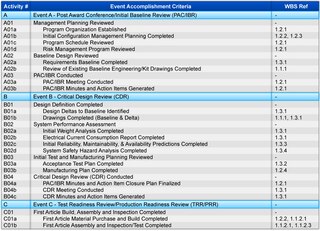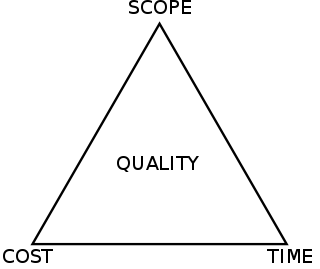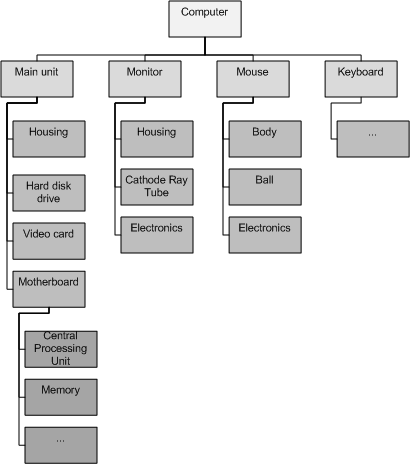Project management is the process of leading the work of a team to achieve all project goals within the given constraints. This information is usually described in project documentation, created at the beginning of the development process. The primary constraints are scope, time, and budget. The secondary challenge is to optimize the allocation of necessary inputs and apply them to meet pre-defined objectives.

A work-breakdown structure (WBS) in project management and systems engineering is a deliverable-oriented breakdown of a project into smaller components. A work breakdown structure is a key project management element that organizes the team's work into manageable sections. The Project Management Body of Knowledge defines the work-breakdown structure as a "hierarchical decomposition of the total scope of work to be carried out by the project team to accomplish the project objectives and create the required deliverables."
A project plan, according to the Project Management Body of Knowledge (PMBOK), is: "...a formal, approved document used to guide both project execution and project control. The primary uses of the project plan are to document planning assumptions and decisions, facilitate communication among project stakeholders, and document approved scope, cost, and schedule baselines. A project plan may be summarized or detailed."
Project management software (PMS) has the capacity to help plan, organize, and manage resource tools and develop resource estimates. Depending on the sophistication of the software, it can manage estimation and planning, scheduling, cost control and budget management, resource allocation, collaboration software, communication, decision-making, quality management, time management and documentation or administration systems. Numerous PC and browser-based project management software and contract management software products and services are available.

PRINCE2 is a structured project management method and practitioner certification programme. PRINCE2 emphasises dividing projects into manageable and controllable stages.
In project management, a schedule is a listing of a project's milestones, activities, and deliverables. Usually dependencies and resources are defined for each task, then start and finish dates are estimated from the resource allocation, budget, task duration, and scheduled events. A schedule is commonly used in the project planning and project portfolio management parts of project management. Elements on a schedule may be closely related to the work breakdown structure (WBS) terminal elements, the Statement of work, or a Contract Data Requirements List.

In systems engineering, information systems and software engineering, the systems development life cycle (SDLC), also referred to as the application development life cycle, is a process for planning, creating, testing, and deploying an information system. The SDLC concept applies to a range of hardware and software configurations, as a system can be composed of hardware only, software only, or a combination of both. There are usually six stages in this cycle: requirement analysis, design, development and testing, implementation, documentation, and evaluation.
A statement of work (SOW) is a document routinely employed in the field of project management. It is the narrative description of a project's work requirement. It defines project-specific activities, deliverables and timelines for a vendor providing services to the client. The SOW typically also includes detailed requirements and pricing, with standard regulatory and governance terms and conditions. It is often an important accompaniment to a master service agreement or request for proposal (RFP).
Product-based planning is a fundamental part of the PRINCE2 approach to project management, and is a method of identifying all of the products that make up or contribute to delivering the objectives of the project, and the associated work required to deliver them. The documents which define the Project itself are also considered Products.

Scrum is an agile project management system commonly used in software development, although it is also used in other fields including research, sales, marketing, education, and advanced technologies. It is designed for teams of ten or fewer members who break their work into goals to be completed within time-boxed iterations, called sprints. Each sprint is no longer than one month and most commonly lasts two weeks. The scrum team assesses progress in time-boxed daily meetings of up to 15 minutes, called daily scrums. At the end of the sprint, the team holds two further meetings: one sprint review intended to demonstrate the work done for stakeholders and solicit feedback, and one sprint retrospective intended to enable the team to reflect and improve.
Project workforce management is the practice of combining the coordination of all logistic elements of a project through a single software application. This includes planning and tracking of schedules and mileposts, cost and revenue, resource allocation, as well as overall management of these project elements. Efficiency is improved by eliminating manual processes, like spreadsheet tracking to monitor project progress. It also allows for at-a-glance status updates and ideally integrates with existing legacy applications in order to unify ongoing projects, enterprise resource planning (ERP) and broader organizational goals. There are a lot of logistic elements in a project. Different team members are responsible for managing each element and often, the organisation may have a mechanism to manage some logistic areas as well.

In the United States Department of Defense, the Integrated Master Plan (IMP) and the Integrated Master Schedule (IMS) are important program management tools that provide significant assistance in the planning and scheduling of work efforts in large and complex materiel acquisitions. The IMP is an event-driven plan that documents the significant accomplishments necessary to complete the work and ties each accomplishment to a key program event. The IMP is expanded to a time-based IMS to produce a networked and multi-layered schedule showing all detailed tasks required to accomplish the work effort contained in the IMP. The IMS flows directly from the IMP and supplements it with additional levels of detail——both then form the foundations to implement an Earned Value Management System.
A glossary of terms relating to project management and consulting.

The project management triangle is a model of the constraints of project management. While its origins are unclear, it has been used since at least the 1950s. It contends that:
- The quality of work is constrained by the project's budget, deadlines and scope (features).
- The project manager can trade between constraints.
- Changes in one constraint necessitate changes in others to compensate or quality will suffer.
Small-scale project management is the specific type of project management of small-scale projects. These projects are characterised by factors such as short duration; low person hours; small team; size of the budget and the balance between the time committed to delivering the project itself and the time committed to managing the project. They are otherwise unique, time delineated and require the delivery of a final output in the same way as large-scale projects.
ManagePro is a project and performance management software product produced by Angbert Enterprises, LLC, a US software and IT consulting company headquartered in Downey, California.
The following outline is provided as an overview of and topical guide to project management:
The goals breakdown structure (GBS) is a hierarchical structure linking high-level objectives or goals to more detailed goals. The GBS was originally developed for project management, but applies to product development and the organization as a whole. The concept is based on the Work Breakdown Structure (WBS) popular in the project management discipline. Like the WBS, project goals exhibit a hierarchical structure. The highest-level defines the overall goal or mission for the project. The next level down sets the goals the organization intends to achieve from the project. These might include such items as profit, market share, etc. The next layer down defines the features the products must exhibit to achieve the organization's goals. The next layer down defines the specifications each product or component of the product must have to meet the products features.
A value breakdown structure (VBS) is a project management technique introduced by Stephen Devaux as part of the total project control (TPC) approach to project and program value analysis.
Breakdown structure may refer to:






